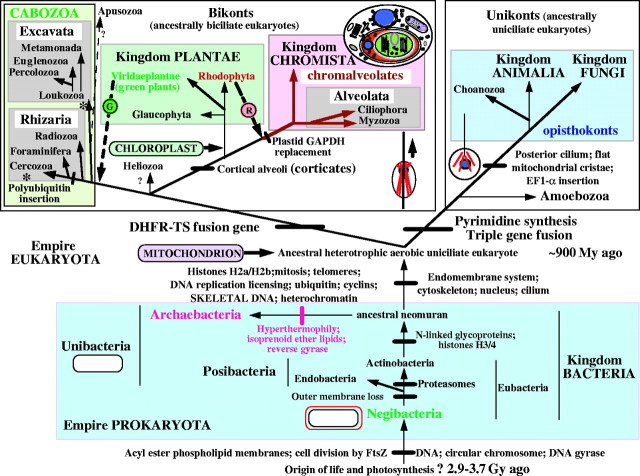Fig. 2.
The tree of life based on molecular, ultrastructural and palaeontological evidence. Contrary to widespread assumptions, the root is among the eubacteria, probably within the double-enveloped Negibacteria, not between eubacteria and archaebacteria (Cavalier-Smith, 2002b); it may lie between Eobacteria and other Negibacteria (Cavalier-Smith, 2002b). The position of the eukaryotic root has been nearly as controversial, but is less hard to establish: it probably lies between unikonts and bikonts (Lang et al., 2002; Stechmann and Cavalier-Smith, 2002, 2003). For clarity the basal eukaryotic kingdom Protozoa is not labelled; it comprises four major groups (alveolates, cabozoa, Amoebozoa and Choanozoa) plus the small bikont phylum Apusozoa of unclear precise position; whether Heliozoa are protozoa as shown or chromists is uncertain (Cavalier-Smith, 2003b). Symbiogenetic cell enslavement occurred four or five times: in the origin of mitochondria and chloroplasts from different negibacteria, of chromalveolates by the enslaving of a red alga (Cavalier-Smith, 1999, 2003; Harper and Keeling, 2003) and in the origin of the green plastids of euglenoid (excavate) and chlorarachnean (cercozoan) algae—a green algal cell was enslaved either by the ancestral cabozoan (arrow) or (less likely) twice independently within excavates and Cercozoa (asterisks) (Cavalier-Smith, 2003a). The upper thumbnail sketch shows membrane topology in the chimaeric cryptophytes (class Cryptophyceae of the phylum Cryptista); in the ancestral chromist the former food vacuole membrane fused with the rough endoplasmic reticulum placing the enslaved cell within its lumen (red) to yield the complex membrane topology shown. The large host nucleus and the tiny nucleomorph are shown in blue, chloroplast green and mitochondrion purple. In chlorarachneans (class Chlorarachnea of phylum Cercozoa) the former food vacuole membrane remained topologically distinct from the ER to become an epiplastid membrane and so did not acquire ribosomes on its surface, but their membrane topology is otherwise similar to the cryptophytes. The other sketches portray the four major kinds of cell in the living world and their membrane topology. The upper ones show the contrasting ancestral microtubular cytoskeleton (ciliary roots, in red) of unikonts (a cone of single microtubules attaching the single centriole to the nucleus, blue) and bikonts (two bands of microtubules attached to the posterior centriole and an anterior fan of microtubules attached to the anterior centriole). The lower ones show the single plasma membrane of unibacteria (posibacteria plus archaebacteria), which were ancestral to eukaryotes and the double envelope of negibacteria, which were ancestral to mitochondria and chloroplasts (which retained the outer membrane, red).

